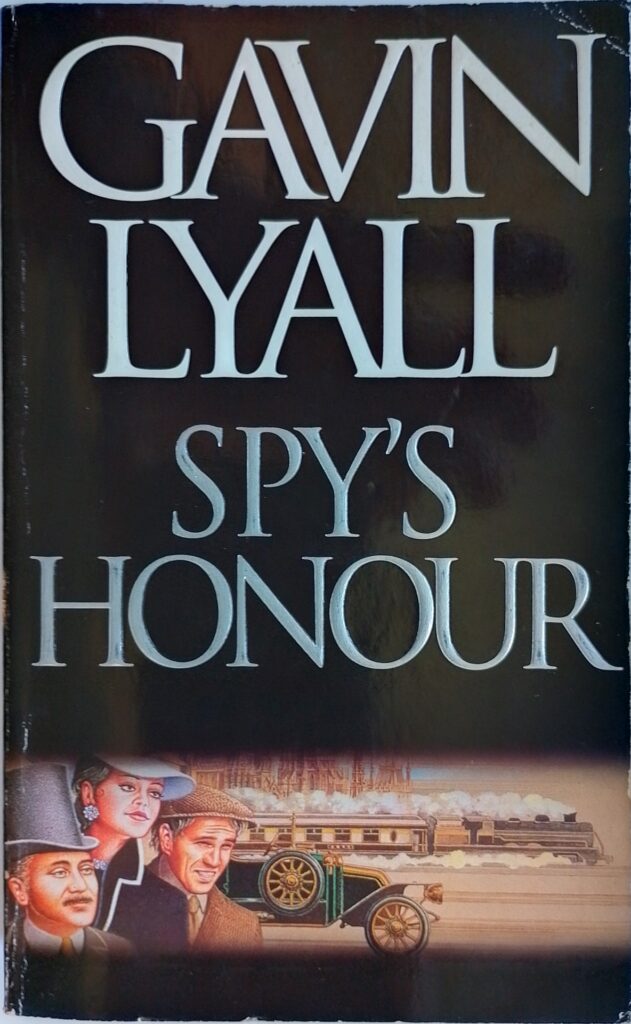First published 1993. Coronet paperback, 1994, pp 383, c.130,000 words.
Gavin Lyall wrote a series of successful thrillers from the 1940s through to the 1990s. Initially they were in the in the Alistair McLean and Hammond Innes mould of ordinary people sucked in to some extraordinary situation. A number were set in the world of aviation, a successful device in those early decades when fighter pilots had emerged as glamorous heroes from the second world war. In his middle years, Lyall wrote a series about an insider, Major Maxim, a soldier brought into the heart of government to lend some action-oriented muscle to solving state problems. Somehow Lyall never got lifted into the most successful rank of thriller writers: Maxim never became Bond. None of his books made it into film or onto television, although several were optioned and worked up. This book is the first of a quartet of his last novels for which he again changed the formula. These books were never a great success either.
The setting here is Edwardian Europe, mostly 1913. There are seething resentments in every country, stoked by the collapsing Ottoman Empire and tottering Hapsburg rule of Austro-Hungary. The Balkans are a powder keg, Germany is expanding its military muscle in a direct challenge to the British Empire. Minor skirmishes – proxy wars – have already broken out. There are spies about, but they are a despised breed, mostly concerned with individual branches of military intelligence. Someone in the British establishment decides they need a separate organisation to get a more rounded view. A bankrupt army officer is dragooned in and he recruits an Irishman also through blackmail. They begin to set up an intelligence network – an embryonic Le Carré world where no one quite knows whom to trust or quite what they are working to achieve. A rich American woman is also unwittingly used to help but is soon joining in the fun with gusto. All the main characters are excellent original creations and, most importantly, have early twentieth century sensibilities, rather than early twenty-first century ones, which so often seems to be the case with dramas set in the past.
This is ripping yarn territory. It could be Buchan’s Hannay or McDonald Frasier’s Flashman, sprinkled with elements of Conan Doyle’s Holmes and Watson. The story has three acts: delivery of codes to Paris involving French royalists and a dual, Kiel during its yachting week attended by the great and the good but where the Kiel canal has almost finished being expanded to allow the German fleet to pass freely and rapidly between the Baltic and the North Sea, and finally to Budapest where an American lawyer is about to deliver a lecture that could have explosive consequences. These elements are all cleverly linked together with lots of double-crosses, fine scrapes and occasional violence. There are dead bodies but little graphic bloody details.
Lyall usually writes very fluidly, but in this case it has become rather disjointed. In a spy thriller one expects confusion and disorientation, but frequently I felt that I had missed something. It is almost as though he had written a substantially longer book and an editor told him to cut it down, so he deleted what he thought was extraneous, but as he was so familiar with the story he didn’t notice the cuts into bone. An alternative view is that this is a hyper-realist work where the human thought process in all its discontinuities, rapid jumps in trains of thought, unfinished thoughts and odd popping up of memory are laid out on the page. For example, someone is described as having ‘a face that was very fashionable at the time, virtually just a profile…’ [p133] or this paragraph: ‘ “Oh?” She was surprised by her own disappointment; her image of Ranklin, pale and disjointed though it was, hadn’t included heroizing himself. She had felt an odd sort of bond with him, oblique to the normal planes of friendship, in knowing almost from the start a vital secret of his life, almost before she knew anything of his public self. In fact, the public self seemed mostly to be “James Spencer” facades, But why pretend to her?’ [p230].
The heart-blood of a spy story is here: the piling up of conflicts of interest and suspect motives which we do have here. The characters are novel and engaging. Lyall has a great reputation for accurate details, so I assume that the settings, background and public events have been thoroughly researched; they certainly had a strong air of verisimilitude. There are some nice touches of humour such as ‘If there was one thing at which the English still unquestionably led the world, it was handling umbrellas.’ [p339]
I really wanted to like this book, but the occasional oddly articulated sentence made it harder going than the smooth, fun ride it should have been.
© William John Graham, March 2023

